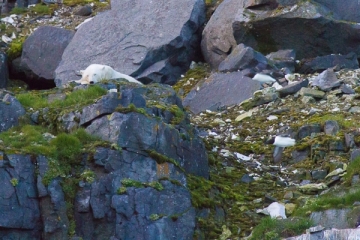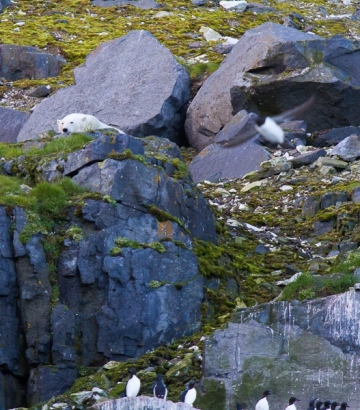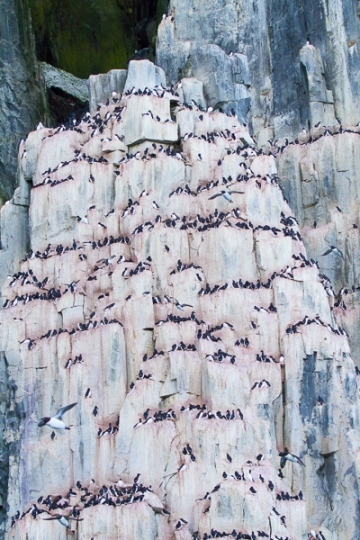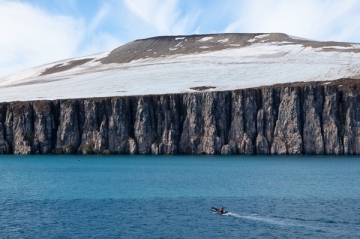During the night, we cross the 80th parallel on our way to Alkefjellet, the site in Svalbard of a large breeding colony of Brünichs guillemots, a small brown and white bird that prefers to nest on sheer cliff faces. This turns out to be a zodiac cruise with a difference – a sharp-eyed passenger spots a polar bear feeding on the birds on a rocky ledge. By the time my zodiac arrives, the bear has eaten its fill of perplexed birds that can’t choose between abandoning their nests or losing their lives, and is napping on a ledge. There is nowhere for the polar bear to go – it can’t climb up the cliff face, and there is nowhere to swim to, so it will most likely stay there for the summer, feeding on the birds, until the winter ice provides it with a bridge to relocate to another area in Svalbard. On the way back to the ship, we spot fin whales in the distance, and quite near to our zodiac. The conditions are not good enough to approach the whales, and it is a wet ride back to Le Boreal.
The plan this afternoon was to go wildlife spotting in Whalenbergfjorden, however word is received from another ship in the area that 200-300 walruses have hauled out on Lågøya island, part of Svalbard, and well above the 80th parallel. So off we go in search of walruses.
We arrive around 5 pm to find the walruses still in residence, and the usual perimeter guard against polar bears is established. Walruses are skittish on land, and we are initially not allowed closer than 75 metres. As the walruses do not show signs of taking off, we advance like a Roman phalanx in three stages until we are about 40m away from them. They seem to be too warm and sleepy in the sun to be bothered by the new arrivals. Once hunted almost to extinction, walrus numbers are slowly recovering.
The pesky Arctic terns also breed on this island in the Svalbard archipelago and make their presence felt to those who still haven’t gotten the message to stay away from their breeding areas.
no images were found
After dinner, Captain Marchesseau decides to sail for another hour further north, to the edge of the pack ice leading to the North Pole. Conditions are perfect, and whilst a polar bear is sighted a mile off into the pack ice, there are enough bear tracks to keep me occupied. There are also at least four ice-breakers working their way through the ice that are visible with the naked eye. The Ortelius (who we passed this morning and has since continued its journey north), the Origa (a small Norwegian survey ship), the Polar Pioneer, and another Russian ice-breaker. Whilst Le Boreal is ice-strengthened, she isn’t an ice-breaker and the Captain doesn’t risk doing anything more than pushing through weak floating ice pieces at the edge of the ice field.A new record is achieved for Le Boreal today, she reaches 80⁰50’32N, 1018km from the North Pole according to GPS reading before Le Boreal turns south. The GPS co-ordinates are later painted onto the interior barrier of the deck of the bridge. 24 hours of daylight means that it is broad daylight in the ice field at midnight.
no images were found
The seas are calm, Le Boreal is stable and is surprisingly fast…she easily outpaces other ships in the area with little apparent effort. It is always clear when we are behind schedule – she speeds through the water like an express train.





